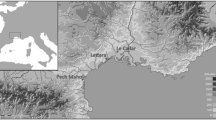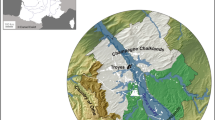Abstract
Excavations at Tell Brak in northeast Syria have uncovered two monumental non-domestic structures from the fourth and third millennia b.c. respectively, containing evidence for large-scale supra-household economic organisation. The charred plant remains from these structures include glume wheat, two-row hulled barley and flax, all found in storage contexts. In the fourth millennium b.c. (the late Chalcolithic), barley grain and flax seeds have been found in storage contexts, as well as glume wheat chaff, indicating the economic importance of this by-product of crop processing. In the third millennium b.c. (the early Bronze Age), barley is the only crop found in a definite storage context, indicating that storage practices may have changed by this time and focused on a much narrower range of crops to be held in communal storage.







Similar content being viewed by others
References
Charles M, Bogaard A (2001) Third Millennium B.C. charred plant remains from Tell Brak. In: Oates D, Oates J, MacDonald H (eds) Excavations at Tell Brak, vol 2. MacDonald Institute, Cambridge, pp 301–326
Emberling G, McDonald H (2001) Excavations at Tell Brak 2000: preliminary report. Iraq 63:21–54
Emberling G, McDonald H (2003) Excavations at Tell Brak 2001–2002: preliminary report. Iraq 65:1–75
French DH (1971) An experiment in water sieving. Anat Stud 21:59–64
Guest E (1966) Flora of Iraq, vol 1. Ministry of Agriculture, Baghdad
Hald MM (2001) Plant remains from the 2000 excavation at Tell Brak, area TC: preliminary results. Iraq 63:40–45
Hald MM (2008) A thousand years of farming: late Chalcolithic agricultural practices at Tell Brak in northern Mesopotamia. BAR, Oxford (in press)
Jacobsen T (1976) The treasures of darkness: a history of Mesopotamian religion. Yale University Press, New Haven
Jones GEM (1984) Interpretation of archaeological plant remains: ethnographic models from Greece. In: Van Zeist W, Casparie WA (eds) Plants and ancient man: studies in palaeoethnobotany. Balkema, Rotterdam, pp 43–61
Jones G (1987) A statistical approach to the archaeological identification of crop processing. J Archaeol Sci 14:311–323
Jones G (1990) The application of present-day cereal processing studies to charred archaeobotanical remains. Circaea 6:91–96
Matthews D, Eidem J (1993) Tell Brak and Nagar. Iraq 55:201–207
McCorriston J (1995) Preliminary archaeobotanical analysis in the middle Khabur valley, Syria and studies of socioeconomic change in the early third millennium b.c. Bull Canad Soc Mesop Stud 29:33–46
Miller N (1997) Sweyhat and Hajji Ibrahim: some archaeobotanical samples from the 1991 and 1993 seasons. In: Zettler R (ed) Subsistence and settlement in a marginal environment: Tell es-Sweyhat, 1989–1995 preliminary report (MASCA Research Papers 14). University of Pennsylvania Museum, Philadelphia, pp 95–122
Oates J, McMahon A, Karsgaard P, al-Quntar S, Ur J (2007) Early Mesopotamian urbanism: a new view from the north. Antiquity 81:585–600
Powell MA (1990) Urban-rural interface: movement of goods and services in a third millennium city-state. In: Aerts E, Klengel H (eds) The town as regional economic centre in the ancient Near East. Leuven University Press, Leuven, pp 7–14
Rothman M (ed) (2001) Uruk Mesopotamia and Its Neighbors. Cross-cultural interactions in the era of state formation. School of American Research Press/James Currey, Santa Fe/Oxford
Stone, N (2002) Some archaeobotanical samples from third millennium B.C. Tell Brak. Unpublished masters thesis, University of Sheffield
Townsend CC, Guest E (1966–1985) Flora of Iraq, vol 2 (1966); vol 9 (1968); vol 3 (1974); vol 4 (1980); vol 8 (1985). Ministry of Agriculture, Baghdad
Van Zeist W (2003) Comments on plant cultivation at two sites on the Khabur, North-eastern Syria. In: Van Zeist W (ed) Reports on archaeobotanical studies in the Old World. Groningen, pp 33–60
Van Zeist W, Bakker-Heeres JAH (1988) Archaeobotanical studies in the Levant 4. Bronze Age sites on the north Syrian Euphrates. Palaeohistoria 27:247–316
Weiss H, Courty MA, Wetterstrom W, Guichard F, Senior L, Meadow R, Curnow A (1993) The genesis and collapse of third millennium North Mesopotamian civilization. Science 261:995–1004
Weiss H, de Lillis F, De Moulins D, Eidem J, Guilderson T, Kasten U, Larsen TE, Mori L, Ristvet L, Rova E, Wetterstrom W (2002) Revising the contours of history at Tell Leilan. Ann arch arab syr Cinquant (unpaginated article from the website http://leilan.yale.edu/pubs/all.html)
Acknowledgments
The authors wish to thank George Willcox, Tim Skuldbøl, and two anonymous reviewers for their valuable comments. MMH wishes to thank the University of Sheffield (Edgar Allen Scholarship) for funding her doctoral research, during which time much of the above analysis was carried out. She also wishes to thank the Danish Research Council for the Humanities for funding her postdoctoral research including the writing up of this paper.
Author information
Authors and Affiliations
Corresponding author
Additional information
Communicated by G. Willcox.
Electronic supplementary material
Below is the link to the electronic supplementary material.
Rights and permissions
About this article
Cite this article
Hald, M.M., Charles, M. Storage of crops during the fourth and third millennia b.c. at the settlement mound of Tell Brak, northeast Syria. Veget Hist Archaeobot 17 (Suppl 1), 35–41 (2008). https://doi.org/10.1007/s00334-008-0154-x
Received:
Accepted:
Published:
Issue Date:
DOI: https://doi.org/10.1007/s00334-008-0154-x




